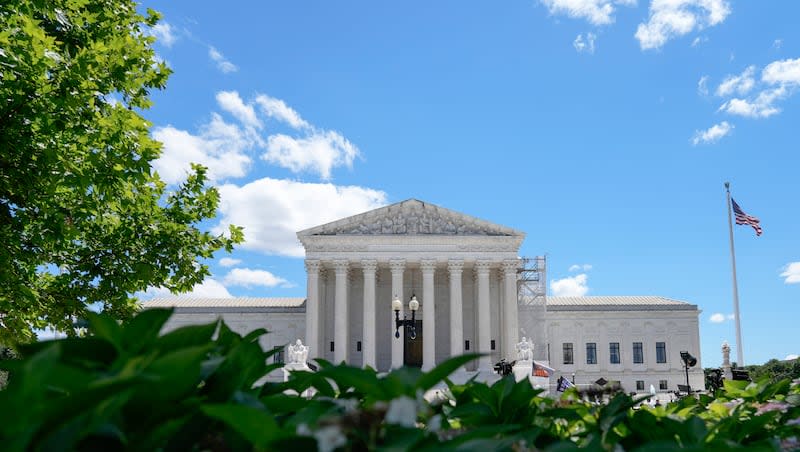5 key questions the Supreme Court will answer next

The Supreme Court wrapped up its latest term last week by releasing its final few rulings and an order list with updates from the justices’ last meeting before their summer break.
The list highlighted five new additions to the Supreme Court’s next term, including a case on age-verification requirements on websites that might be harmful to minors.
There are now nearly 30 cases set to be heard during the 2024-25 term, and the justices will likely add at least 50 more to its schedule over the next eight months.
The Supreme Court will be back in session in three months — on Oct. 7 — to hear its first oral arguments of the new term.
Cases the Supreme Court will hear next
Here’s a look at some of the most notable issues the Supreme Court will consider later this year.
Gender-related health care for minors
Case name: United States v. Skrmetti
Key question: Does a Tennessee law preventing transgender children and teens from accessing certain gender-related medical treatments, like hormone therapy, violate the Constitution since other young people can still access those treatments?
Lower court ruling: The teens who challenged Tennessee’s law secured a partial victory at the district court level. The judge put aspects of the law dealing with hormone therapy and puberty blockers on hold, but not the part dealing with gender-transition surgeries, since the teens hadn’t been candidates for such surgeries. But the 6th U.S. Circuit Court of Appeals later overturned that decision and reinstated the law.
Ghost guns
Case name: Garland v. VanDerStok
Key question: Should a weapon parts kit that can be used by the buyer to assemble a “ghost gun” be regulated the same as a more traditional firearm?
Lower court ruling: A federal district court judge said the Bureau of Alcohol, Tobacco, Firearms, and Explosives’ regulations for ghost guns should be on hold while the case plays out, and the 5th U.S. Circuit Court of Appeals agreed. But in August, the Supreme Court overturned that temporary order, allowing the ATF’s regulations to take effect. Since then, the lower courts have again ruled against the ATF, deciding that gun kits do not fall under the Gun Control Act of 1968′s definition of firearm.
Age-verification on pornography sites
Case name: Free Speech Coalition v. Paxton
Key question: When adults challenge kid-focused age-verification rules for websites with adult content, what legal test should judges use when considering the challenged policies?
Lower court ruling: The 5th U.S. Circuit Court of Appeals upheld Texas’ age-verification rules, but now the Supreme Court will debate whether the judges asked the wrong questions.
A major environmental law
Case name: Seven County Infrastructure Coalition v. Eagle County, Colorado
Key question: What’s the scope of the National Environmental Policy Act?
Lower court ruling: The Surface Transportation Board said a proposed rail project in Utah could satisfy the National Environmental Policy Act’s environmental review requirements without studying how the rail line’s eventual cargo — crude oil — would affect the environment. The D.C. Circuit Court of Appeals applied the act differently, deciding that the rail project can’t move forward until organizers undertake a broader environmental impact study.
CBD products
Case name: Medical Marijuana v. Horn
Key question: What counts as a “business or property” under the Racketeer Influenced and Corrupt Organizations, or RICO, Act?
Lower court: A federal district court ruled against a former truck driver attempting to use RICO to challenge the makers of a CBD product that he alleged had led to him losing his job through its misleading advertising. It said that RICO doesn’t apply to a personal injury like the loss of your job. The 2nd U.S. Circuit Court of Appeals then reinstated the man’s RICO claim, ruling that losing your job amounts to a harm to your business, which is part of the law.
Supreme Court trends
Although the Supreme Court will more than double the current list of 2024-25 cases by this time next year, it’s already clear that the justices will return to some familiar themes next term.
For example, the ghost guns case has much in common with the recently concluded term’s case on bump stocks. In each, the Supreme Court was asked to consider how to apply old gun laws to the modern gun market and how much leeway the executive branch has to enforce new gun restrictions in the absence of new laws from Congress.
And in the case on environmental impact studies, the Supreme Court has yet another opportunity to limit the reach of the EPA. In the past two years, the justices have done just that in cases on air pollution rules and protection for wetlands.
It’s also notable that the Supreme Court has not yet taken up a First Amendment religion case. Religious freedom played almost no role in the 2023-24 term, breaking a streak of several years in which it took center stage, as the Deseret News previously reported.

